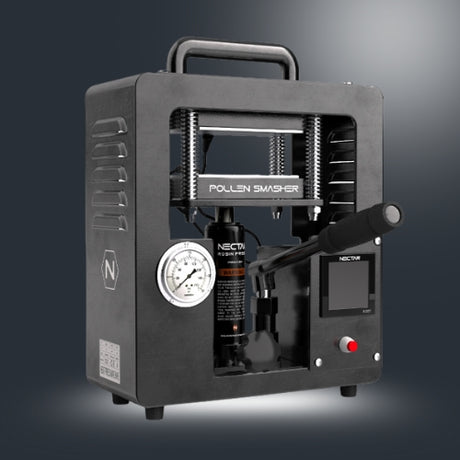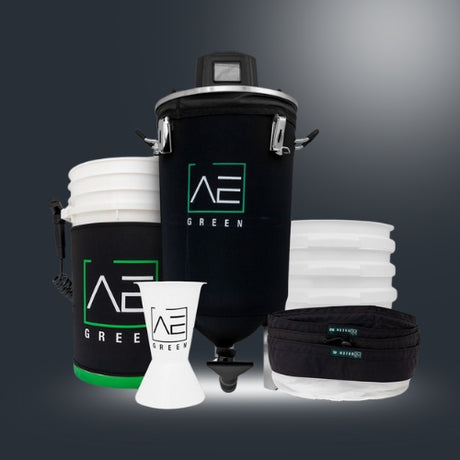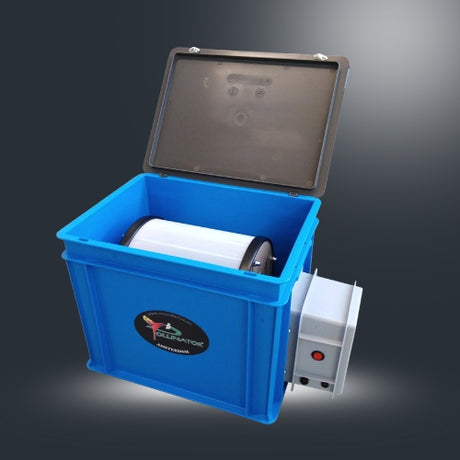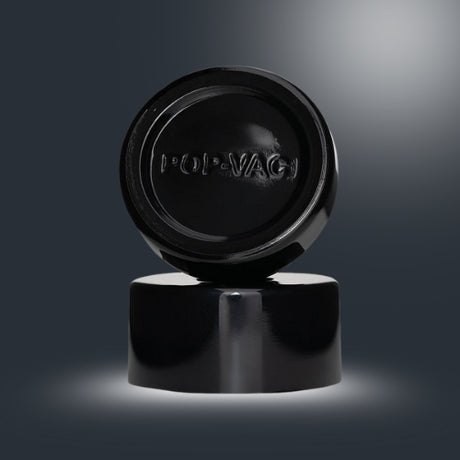- Sold outUp to 27% off
Santa Cruz Shredder
Santa Cruz Shredder - Tray With Sift Screen
6 Colours!
+2Sale price £19.95 Regular price £27.50Unit priceUnavailable Pollinator
Pollinator P150 Extra Drum 70-220 Micron
Up to 150G Capacity
Regular price £176.98Unit priceUnavailablePollinator
Pollinator P500 Extra Drum 70-220 Micron
Up to 500G Capacity
Regular price £239.98Unit priceUnavailable- FREE SHIPPING
Pollinator
Pollinator P150 Dry Sift Tumbler Extractor
Up to 150G Capacity
Regular price £418.95Unit priceUnavailable - BEST SELLER
Qnubu
Qnubu Autosift Automatic Dry Sift Maker
Highly Efficient Time Savee!
Regular price £419.95Unit priceUnavailable - NEW IN!12% off
Squish Tech Extraction
The Kief Thief Hobbyist - Pollen Tumbler
MADE IN THE UK!
Sale price £420.00 Regular price £479.95Unit priceUnavailable - FREE SHIPPING
Pollinator
Pollinator P150 Bottomless Dry Sift Tumbler Extractor
Up to 150G Capacity
Regular price £478.95Unit priceUnavailable - FREE DELIVERY
Pollinator
Pollinator P500 Dry Sift Tumbler Extractor
Up to 500G Capacity
Regular price £668.95Unit priceUnavailable - NEW IN!
Pollinator
Pollinator P500 Bottomless Dry Sift Tumbler Extractor
Up to 500G Capacity
Regular price £728.95Unit priceUnavailable - LANDS JUNE 2026!
SC Filtration
SC Filtration - Plasmastatic Mini Separator (PREORDER-JUNE)
Regular price £949.95Unit priceUnavailable - CUSTOM ORDER
SC Filtration
SC Filtration - Plasmastatic R&D Separator
Regular price £4,699.95Unit priceUnavailable
What Is Dry Sift?
Dry sift is a method for extracting concentrate that utilizes screens or sieves to separate glands from plant material. During the process, the material is agitated over different sized screens, causing the small and delicate glands to break off and fall through. This results in a pure and potent powder that can be further refined or consumed as is. Dry sift is known for its high concentration of glands and terpenes, making it a popular choice among consumers.
Is Dry Sift Solventless Extraction?
In the case of dry sift, no solvents are used. Instead, the extraction process relies solely on mechanical agitation to separate trichomes from the plant material. This makes dry sift a popular choice among those who prefer extraction methods without the use of chemicals, due to its simplicity and the absence of potentially harmful substances.
Other examples of solventless extraction methods include ice water extraction, rosin pressing, and traditional hand-rolling methods. These methods are favoured by some for their perceived purity and the retention of the natural terpene profile of the material being processed.
Different Types Of Dry Sift Equipment?
You can make different types of dry sift using either dry sift screens or pollen tumblers:
Dry Sift Screens:
Standard Dry Sift: Using multiple screens with varying mesh sizes, you can create different grades of dry sift. The finer mesh screens capture smaller glands, resulting in a higher quality sift that is more potent
Multi-Grade Dry Sift: By layering screens with different mesh sizes, you can create multiple grades of dry sift in a single extraction session. This allows you to collect various qualities of sift, each with its own potency and flavour profile.
Pollen Tumblers:
Single-Grade Dry Sift: Pollen tumblers use a rotating drum or cylinder lined with a fine mesh to separate trichomes from the plant material. This method typically produces a single grade of dry sift, as the tumbling action effectively sifts all trichomes through the mesh.
Variable Grade Dry Sift: Some pollen tumblers allow you to adjust the speed and duration of the tumbling process, which can influence the size and quality of the trichomes collected. By experimenting with different settings, you can create dry sift of varying grades and potency.
What's A Dry Sift Screen?
A dry sift screen is a tool utilized in the dry sift extraction process. It comprises a frame with a mesh screen stretched tightly across it, typically made of stainless steel with varying hole sizes. During extraction, dried plant material is gently agitated or rubbed against the screen. Glands, break off from the material and pass through the mesh, while larger plant matter remains on top. Dry sift screens come in different mesh sizes, allowing for the extraction of sift with varying qualities, from fine to coarse. Overall, they provide a straightforward and solventless method for extracting cannabinoids and terpenes from plant material.
Why Use A Dry Sift Screen?
Dry sift screens are utilized for several reasons in the extraction process. Primarily, they offer a solventless method of extracting glands from plant material, avoiding the use of chemicals typical in solvent-based extraction methods. These screens facilitate the separation of glands from the plant matter, resulting in a relatively pure concentrate. Moreover, by employing screens with different mesh sizes, users can exercise control over the quality of the sift produced. Finer mesh screens capture smaller glands, yielding a higher quality and more potent sift, while coarser screens may produce a product with varying consistency and potency.
What's A Pollen Tumbler?
A pollen tumbler, also referred to as a dry sift tumbler or trim tumbler, is a device utilized in the process of extracting trichomes from plant material. It consists of a rotating drum or cylinder lined with a fine mesh screen. The plant material, typically dried flowers or trim, is placed inside the tumbler, and then the drum is set in motion. As the drum rotates, the plant material is agitated against the mesh screen, causing the trichomes to break off and fall through the screen while the larger plant matter remains inside the drum.
Pollen tumblers are commonly employed to produce dry sift, a concentrated resin powder containing various compounds. The sift collected from the tumbler can vary in quality depending on factors such as the duration of tumbling and the speed of rotation. Some pollen tumblers also allow for adjustments to these settings, providing greater control over the extraction process.
Why Use A Pollen Tumbler?
Pollen tumblers are favoured for several reasons. Firstly, they offer an efficient means of extracting glands from plant material, ensuring a higher yield in a shorter duration compared to manual methods. Their consistent agitation ensures uniform extraction, leading to predictable potency and flavour profiles in the resulting extract. Moreover, these tumblers are automated, requiring minimal manual intervention once the process begins, thus enhancing productivity. Additionally, their versatility allows for the extraction of various compounds from different botanical sources, not limited to a specific plant type. Some models even offer adjustable settings, providing operators with precise control over factors such as tumbling speed and duration, enabling customization of the extract's characteristics. Overall, pollen tumblers present a convenient and effective solution for producers seeking to extract glands efficiently and consistently from plant material for various botanical applications.
Which Is Better A Dry Sift Screen? Or A Pollen Tumbler?
Determining whether a dry sift screen or a pollen tumbler is better depends on individual preferences, specific needs, and the scale of extraction. Each method has its advantages:
Dry Sift Screen:
Control: Dry sift screens offer precise control over the extraction process, allowing users to adjust the mesh size and manually agitate the plant material.
Quality: With careful handling, dry sift screens can produce high-quality sift with distinct flavour profiles and potent concentrations.
Cost-Effectiveness: They are generally more affordable than pollen tumblers and require minimal maintenance.
Versatility: Dry sift screens can be used for small-scale extractions and are suitable for various plant materials.
Pollen Tumbler:
Efficiency: Pollen tumblers automate the extraction process, enabling faster and more consistent extraction of trichomes.
Consistency: They ensure a uniform extraction, leading to consistent potency and flavour profiles in the resulting extract.
Scalability: Pollen tumblers are suitable for large-scale extraction operations, making them ideal for commercial producers.
Ease of Use: They require minimal manual intervention once set up, allowing operators to focus on other tasks.
Ultimately, the choice between a dry sift screen and a pollen tumbler depends on factors such as budget, desired output quality, scale of extraction, and personal preference. Small-scale or home producers may prefer the control and affordability of dry sift screens, while larger operations may opt for the efficiency and scalability of pollen tumblers.

































































